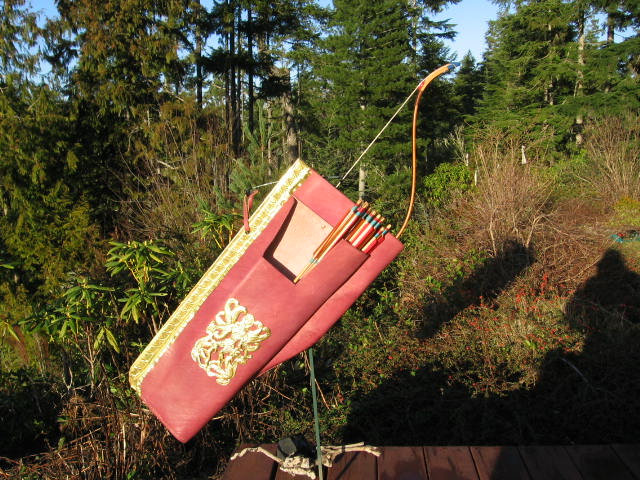Difference between revisions of "Arion the Wanderer"
| Line 5: | Line 5: | ||
A&S PROJECTS | A&S PROJECTS | ||
| + | |||
| + | [[File:Samples of Arion's work.jpg]] | ||
A Scythian Gorytos, circa 400 BC. The Scythians were nomadic horsemen who ranged across the Eurasian steppe. They were known for their very small, but powerful composite bows. Much of what we know of the Scythians comes from burial mounds that have been locked in permafrost and ice for the last 2,000 - 3,000 years and Herodotus' History. [[Image:IMG 0421.JPG]] | A Scythian Gorytos, circa 400 BC. The Scythians were nomadic horsemen who ranged across the Eurasian steppe. They were known for their very small, but powerful composite bows. Much of what we know of the Scythians comes from burial mounds that have been locked in permafrost and ice for the last 2,000 - 3,000 years and Herodotus' History. [[Image:IMG 0421.JPG]] | ||
Revision as of 18:40, 6 October 2012
I am Arion, called the Wanderer, a 4th century BC anachronism in the SCA culture. I was born to a Greek mother and Celt father in the Greek trading colony of Olbia in the Scythian lands north of the Euxine Sea (Black Sea). My father traded gold and silver torcs between his homeland of Alesia in Gaul, along the Danube River, all the way to Scythia. When I reached an age where my father thought me useful, he took me along and taught me his trade. After he died, I expanded my horizons and traveled as far south as Rome. This was a most profitable trip. When I was trading with the Sonones in the Po river valley, Roman "ambasadors" killed a Senone chieftian. As a matter of honor, the Senone tribesmen lead by Brennus, traveled to Rome and sacked the city. It fell except for the fortified Capitoline Hill. After seven months of raids in the country side and multiple failed attempts to capture the Capitoline Hill brought us to an impass, the Romans agreed to give us 1,000 lbs of gold to leave.
The SCA has given me the opportunity to explore my artistic nature, that usually lay smouldering in my day job. I enjoy metal working (including repousse' and coin die engraving), leather working, and wood working (including wood carving, and bow/arrow construction). I also like to kill people with arrows on the war field and poke holes in archery and thrown weapons targets.
A&S PROJECTS
A Scythian Gorytos, circa 400 BC. The Scythians were nomadic horsemen who ranged across the Eurasian steppe. They were known for their very small, but powerful composite bows. Much of what we know of the Scythians comes from burial mounds that have been locked in permafrost and ice for the last 2,000 - 3,000 years and Herodotus' History. 
A Turkish Siper. Ottoman Empire. Used with tiny flight arrows and a Turkish composite bow in flight shooting contests. The goal is to shoot arrows farther than anyone else. The Turks in the Ottoman Empire achieved around 900 yards with this specialized equipment.

A Urness-style wood carving. The Vikings inhabited Scandinavia between the 9th and 11th centuries. Their art developed through a series of styles during this time: · Oseberg: Chubby gripping beasts and intertwining ribbon-shaped animals with round eyes. The bodies are filled with geometric designs. · Borre: Gripping beasts loose body volume and become more ribbon-shaped. The eyes are round. The bodies are filled with geometric designs. New elements include nose, head and tail lappets and spiral hip joints. · Jellinge: The emphasis on gripping is greatly reduced. The ribbon-shaped animal’s bodies are filled with geometric designs. Lappets and spiral hip joints are used. Both round and oval eyes are used. · Mammen: Ribbon-shaped animals with more substantial bodies have round eyes and spiral hip joints. The lappets are developed into foliate patterns. The tendency to fill the body with geometric patterns is reduced. · Ringerike: More naturalistic great beasts with elaborate foliate lappets dominate. Spiral hip joints continue to be used. Geometric patterns filling the body disappear. The eyes become almond-shaped. · Urnes: Great beasts with gently curving bodies, spiral hip joints and almond-shaped eyes. Lappets are greatly reduced. Foliate elements continue as separate vegetal elements and lesser beasts. Wood carving tools used during the Viking era were quite similar to modern ones. The Urnes style carving I did was modeled after one found on the portal of a stave church in Norway. The modifications I did retain the essential elements of the original.

